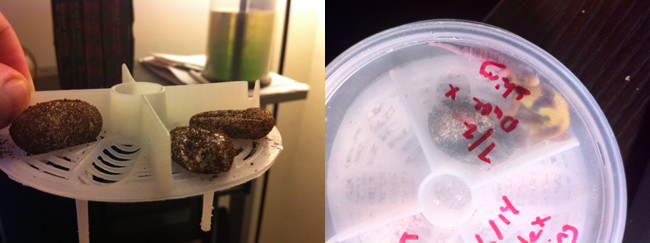A lot has happened in the last month. A second super hypo has hatched, my first hatchling is an eating machine and my Mack Snow has finally bred and laid her first clutch. That last bit of news is a load off of my mind because I’m hoping to get Snowglows from her offspring next year. With any luck they will be Snowglow Raptors. Another bit of good news is that the Sunglow that I won in the KillCrypto.com auction has started to feed. It isn’t to the point where I feel comfortable breeding her but enough so that I think things are going to be OK.
[ad#sponsor]
I guess that only bit of sad news is that my Tremper Patternless has not laid at all this year despite two successful mating attempts. I’m thinking that she is a dud but I’ll try again next year. It isn’t overly disappointing because it wasn’t the most interesting of combinations but it is still disconcerting nonetheless.
With that update I thought I might take a different approach than usual. The last year that I have spent on the gecko related forums I have seen and asked a lot of questions about egg incubation. Having just about finished my first year of incubation I thought I would provide some perspective for other first timers by addressing the three questions I have seen the most.
Dented Eggs
First it’s the dented egg question. I don’t have any experience with eggs denting after being in the incubator but I have had eggs dented when I brought them out of the lay box. The best thing to do is get them in the incubator ASAP and don’t touch them for about a week. In my experience this year they usually plumped up after that amount of time. Those that didn’t ended up moldy and dead.
How Long?
The second most asked question and one that I think we are all wondering after our first clutch is, “How much longer am I going to have to wait!” Well this of course depends on the incubation temperature. That being said I decided that in order to keep myself sane I would set a timer on each clutch at 60 days. So far all my clutches have hatched around the 50 day mark at about 84 degrees. Higher temps equal less time and the opposite is also true.
Incubation Medium
Lastly, there seems to be a lot of debate over which medium to use in your incubation cups. This year I used perlite, with a 0.8 to 1 ratio of water to substrate by weight, because it came with the GEO system I purchased and that is what the developer of that product used. In the past I used vermiculite and standard incubation with great success. The perlite didn’t seem to have any effect at all on the incubation as compared to the vermiculite. There are other products out there like Hatchrite but I can’t speak to their effectiveness from experience. My opinion is it all comes down to trying them out for yourself. There are so many other factors to successful incubation that I think it would take a lengthy study to see if there are any benefits to one substrate over another.

A quick note about the GEO – I love this product and highly recommend it. For someone like me with limited incubator space it has made it easier to accommodate the amount of eggs I got and also saved me deli cups and substrate. The separation of clutches is also a huge plus.
The best incubation advice ever given is, “incubate until there is no debate.” You never know how the egg will react in the incubator and we need to give them every chance we can to hatch before giving up. Please feel free to contact me with any questions or comments. Let me know what you’d like to hear about next.


Just a quick update – As this was being posted my third Super Hypo het Tremper Albino hatched. You can see pictures here: http://www.iherp.com/HerpTrack/MyAnimals/Animal.aspx?AnimalID=75346
Thank you Justin for keeping us up to date on your hatching endeavours, and also addressing those questions that many of us wonder about. I have tweeted your article for its valuable and interesting content to assist all gecko lovers.
I’m so glad to see another breeder using the GEOs. I loved mine this past season though I highly dislike perlite and switched to Supreme Hatching Medium instead and have had much better results. But I find so many variables between hatching mediums as well as how they react depending on what part of the country that you’re in that its hard to pinpoint how one will work over another even from one year to the next.
That made things for me a lot clearer Thanks!